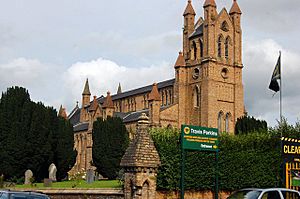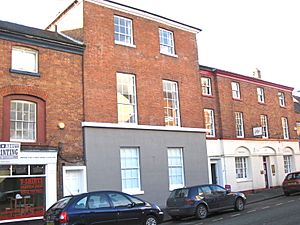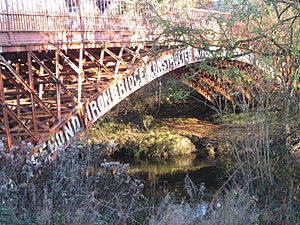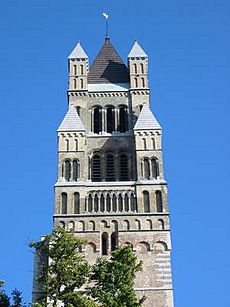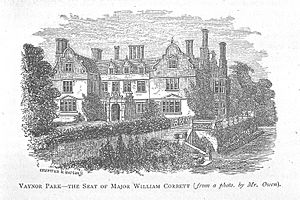Thomas Penson facts for kids
Thomas Penson (around 1790 – 1859) was an important Welsh architect and surveyor. He was known for designing many bridges and buildings. He worked as the official surveyor for Denbighshire and Montgomeryshire counties in Wales.
Contents
About Thomas Penson
His Family
Thomas Penson's father, also named Thomas Penson, was a surveyor too. His father worked for Flintshire county. Thomas Penson the younger had two sons, Thomas Mainwaring Penson and Richard Kyrke Penson. Both of them became architects and worked in Chester.
His Training and Career
Thomas Penson learned his skills from Thomas Harrison, a famous architect and bridge designer in Chester. Penson became the county surveyor for Montgomeryshire in 1817. He held this job until 1859.
He also designed many new roads in the county. Around 1820, he became the county surveyor for Denbighshire as well. He married Frances Kirk in 1814. They first lived in Overton-on-Dee. By 1823, they moved to Oswestry. There, he opened his office, called "Penson's Chambers."
Later, in 1839, his wife inherited Gwersyllt Hall near Wrexham. Penson redesigned this house in a style called Neo-Jacobean. It became their family home. Thomas Penson was also the Mayor of Oswestry in 1840.
Later Life
Thomas Penson was made a Deputy Lieutenant of Denbighshire in 1852. He passed away at Gwersyllt on May 20, 1859.
Amazing Bridges
Penson designed many bridges, especially in Montgomeryshire. He designed 62 bridges in that county alone! He worked with builders like David Davies.
In 1852, a big flood damaged many bridges. Penson then designed new ones to replace them. For example, he designed a new bridge at Caerhowel in 1858. This bridge used strong cast iron arches.
Here are some other bridges Thomas Penson designed:
- Caersws Bridge, at Caersws, built in 1821. It has three masonry arches.
- Long Bridge, at Llanidloes, built in 1826. This masonry arch bridge replaced an older wooden one.
- Long Bridge, at Newtown, built in 1827. Penson later made it wider in 1857.
- Brynderwen Bridge, at Abermule, built in 1852. This is a cast iron arch bridge.
- New Bridge over the River Dee.
- Llanymynech Bridge over the River Vyrnwy.
His Architectural Style
Thomas Penson had a unique building style. He often used a style called Romanesque Revival architecture. This style brought back ideas from ancient Romanesque buildings. He also used elements from German and Flemish "Brick Gothic" styles.
Penson was one of the first to use terracotta in his buildings. Terracotta is a type of baked clay. It was cheaper than carved stone for decorations. His church, Christ Church in Welshpool (1839–44), is one of the earliest examples of terracotta use in Britain.
He built at least six churches in his special Romanesque style. An example is St David's Church in Newtown. It uses buff-colored bricks and terracotta.
|
|
Churches He Designed
- Holy Trinity, Oswestry, 1835–7.
- Christ Church, Welshpool 1839–1844.
- St David's Newtown 1843–47.
- St Agatha's Llanymynech, Shropshire, 1845.
- St Cedwyn, Llangedwyn, Penson added a porch in the 1840s.
- Holy Trinity, Gwersyllt, Wrexham 1850–51.
- Rhosllanerchrugog, Wrexham 1852.
Public Buildings
Penson also designed many public buildings, including:
- Llanfyllin Union Workhouse, 1838. This was a large building for people who needed help.
- Newtown & Llanidloes Union Workhouse at Caersws, 1838–40.
- The Flannel Exchange, Newtown, 1832. This was a market for selling flannel cloth.
- The Montgomeryshire County Gaol, Montgomery (a prison).
- Montgomery Town Hall – Penson rebuilt the top floor in 1828.
- Oswestry The Cross Market, 1848–9.
- Wrexham. The Butcher's Market, Wrexham 1848.
- Wrexham. The Militia Barracks (now Wrexham Museum), 1857.
Schools
Thomas Penson also designed several schools:
- Gwersyllt, Church School.
- Llanwnnog National School, 1850.
- Newtown National School, Canal Road, 1857.
- Wrexham, British School, 1844.
- Oswestry National School, Park Avenue 1841.
Houses
Penson designed or remodeled several houses:
- Aberhafesp Old Rectory 1828–29.
- Pentreheylin, Fourcrosses. Built around 1830.
- Vaynor Park, Berriew, Montgomeryshire. Penson made changes to this house between 1840–53.
- Llanrhaiadr Hall, Denbighshire, 1842.
- Gwersyllt Hall or Hill. This was Penson's own house, remodeled in 1841.
The Cottage Ornée Village at Berriew
Around the late 1830s, Penson worked on houses in the village of Berriew. He helped make Berriew a village with many charming "Cottage Ornée" houses. These houses often had decorative wooden trim and sometimes looked like old timber framed buildings. Penson's style can be seen in the big brick chimneys and fancy decorations on the roofs. He was important in creating this "Tudor picturesque" style in the countryside.
|
|
Images for kids


